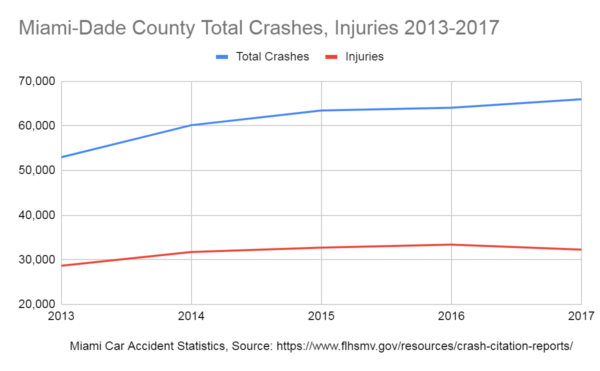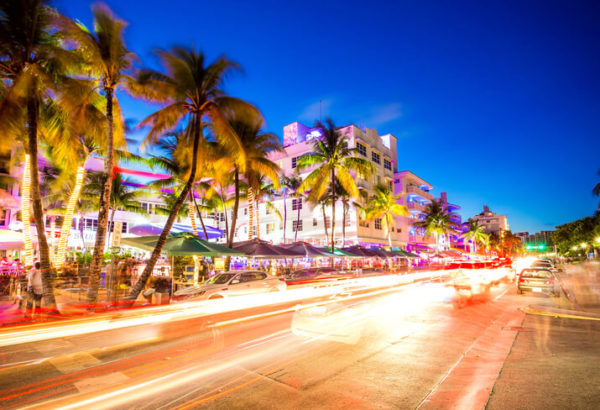Compared to the rest of Florida, Miami-Dade County is not so bad when it comes to car accidents. But compared to the U.S. as a whole, Miami’s roads look incredibly dangerous.
Road fatalities per mile, fatalities per 100,000 people, pedestrian fatalities, DUI accidents, hit and runs — in all of these categories Florida beats the national average. Our state topped the list of “worst drivers in the country” in 2016 and 2017 before easing into eighth place last year. We’re known for being especially dangerous to bicyclists and pedestrians, and Miami’s I-95, in particular, has been ranked as one of the deadliest stretches of road in the country.
Miami shares some of this burden. In the five years between 2013 and 2017, Miami-Dade’s overall car accident rate went up nearly 25%, according to statistics from the FLHSMV. Fatalities increased by 27%, injuries by over 12%.

Florida’s no fault insurance laws also make it difficult for anyone who was injured in a Miami accident to seek the full amount of compensation they’d get in other states. They often need help from a Miami car accident lawyer to help them prove they have a “serious injury” and track down liable parties.
There is no easy way to explain these problems. Glancing at the overall numbers, we’ve noticed that Miami’s car accident statistics mostly make a steady climb upward, like most of the nation.
But underneath those numbers, there’s a complex story — one that indicates a strong need for Miami to change in order to reduce the number of car accidents and save more lives.
Miami-Dade Safer Than Most of Florida …But Still Dangerous
Objectively, Miami leads the state in overall volume of car accidents, too. Its 65,986 accidents in 2017 were barely approached by any county aside from nearby Broward, which had 41,337 accidents that year.
But these numbers look bad only because the county is so populous. When comparing Miami’s fatal accident rate per 100,000 people, we’re in the bottom 5 in the state. Central Florida counties like Putnam have a fatal accident rate over 6 times higher than ours. Rural counties like Glades with a low population but a steady number of road fatalities also trend towards the top of the list.
Miami Car Accident Statistics 2017 – 2013
| Year | 2017 | 2016 | 2015 | 2014 | 2013 |
| Total Crashes | 65,986 | 64,070 | 63,451 | 60,165 | 52,981 |
| Injuries | 32,289 | 33,400 | 32,742 | 31,752 | 28,666 |
| Fatalities | 285 | 294 | 339 | 280 | 224 |
| Pedestrian Crashes | 1,546 | 1,449 | 1,604 | 1,522 | 1,428 |
| Bicyclist Crashes | 805 | 758 | 890 | 989 | 863 |
| CMV* Crashes | 8,929 | 8,314 | 8,270 | 7,757 | 6,866 |
| CMV* Injuries | 1,354 | 921 | 897 | 1,452 | 1,335 |
| CMV* Fatalities | 20 | 17 | 17 | 21 | 15 |
|
Source: Crash and Citation Reports & Statistics *CMV = Commercial Vehicle | |||||
Still, despite this silver lining, there’s no denying that Miami has a ways to go before it is considered safe. Our overall accident volume has climbed steadily, year after year. Our rate also doesn’t have a steady downward climb, which would be taken as a sign of positive progress.
Instead, we’re mostly stuck. Programs like Miami-Dade’s Vision Zero project have failed to lower fatal pedestrian crashes. Efforts to discourage speeding, DUI, and distracted driving have been tempered by the rising volume of drivers overall.
So what’s behind this quagmire? What can Miami do to explain its traffic safety record and, hopefully, reveal a path to improvement?
In an effort to answer these questions, our research uncovered four major trends in Miami car accident statistics.
Miami’s Roads Aren’t Pedestrian and Bike-Friendly
One of the biggest takeaways from Miami car accident trends is that the city — and Florida as a whole — is unacceptably dangerous for people using alternative modes of transportation.
A study by think tank SmartGrowth America listed metro areas with a high rate of pedestrian deaths per 100,000 people. Eight of the top ten cities on the list were in Florida.
The Miami-Fort Lauderdale-West Palm Beach metro area ranked in at #14. It had 1,549 pedestrian fatalities in the 10 year period between 2008 and 2017, creating a fatality rate of 153.5. That’s not nearly as bad as the worst offender: Orlando, with a rate of 313.3.
SmartGrowth America’s study found that the reason pedestrian deaths are increasing is because we have an automobile-focused approach to designing roadways and corridors. These structures aim to funnel as many cars as possible as quickly as possible through an area. Also, many highways act as streets, meaning that they have turnoff exits to local streets and businesses.
The combination of high traffic and car-focused access to areas creates a situation where pedestrians and bicyclists get crowded out.
“We’re not walking more and we’re only driving slightly more than we were back in 2008,” write the study authors. “What is happening is that our streets, which we designed for the movement of vehicles, haven’t changed. In fact, we are continuing to design streets that are dangerous for all people.”
The alternative is to design roadways where cars must slow down before they approach pedestrian crossing areas. That, or keep cars and people separate entirely, such as through the use of bike-only pathways. These sorts of areas are becoming increasingly popular in areas like downtown Miami and Miami beach, but the vast amount of roads outside of metro areas don’t even have sidewalks, let alone pedestrian-only pathways.
Making matters worse, roads get more dangerous in areas where disadvantaged people are forced to walk miles and cross highways to get to work or the store. It’s no mystery why rural Florida counties have a higher rate of accidents — more people are crossing roads where cars go faster.
Miami’s Intersections Have Deadly Designs
While our city has a relatively low accident rate compared to other Florida metro areas, Miami’s dangerous intersections stand out in a state renowned for deadly roads.
Many of the riskiest intersections give cars the impression they should travel fast or make risky moves to navigate. That’s because they were never designed to handle the traffic volume they do today.
What should be happening instead is that traffic should be forced to slow down. Decisions made during navigation should also be less risky, such as directing vehicles through diamond interchanges rather than a regular four-way crossing.
Of course, traffic patterns like these create more congestion and are much more expensive to design and construct, giving engineers an uphill battle when it comes to making intersections safer.
Car Accident Rates in the U.S. Fluctuate Naturally with Gas Prices and Unemployment Levels
The most discouraging pattern comes from looking at national accident rates. Road deaths tend to increase when gas prices are cheap. They tend to decrease when unemployment rates go up and people feel more like conserving gas.
Gas price increases explain the gradual downward trend in fatal accident rates in Miami and across Florida from 2006 – 2013. When oil supplies experienced a glut after OPEC agreed to up production, gas prices fell and death rates rose again.
Fortunately, Miami has seen a drop-off in our death rate at a faster pace than the rest of Florida. Is that because traffic safety initiatives are doing better, or because gas prices are higher in Miami? No one could say.
Florida’s Traffic Enforcement (and Car Insurance Laws) Don’t Hold People Accountable
The final and most compelling trend is that traffic accidents in Miami have gone up in proportion to a decline in traffic tickets. From 2012 to 2017, police departments in Miami-Dade, Broward and Palm Beach issued half a million fewer tickets for speeding and other moving violations. During the same period crashes increased by 33,821.
Florida’s insurance laws also discourage any sort of accountability. Unlike most other no-fault states, drivers aren’t required to carry liability insurance. If they hit someone and hurt them, the only recourse the accident victim has is to sue them or to find another liable party to sue.
These laws may be the reason behind Florida’s disturbingly high hit and run rate. Most drivers can’t help pay for the costs of the injuries they cause, so they have a higher motive to flee instead.
Anyone who is hurt in an accident in Miami does have options, though. They can work with an experienced car accident attorney in Miami to get the maximum amount possible under their personal injury protection (PIP) insurance, uninsured/underinsured motorist insurance (UM/UIM), bodily injury liability insurance (BIL) and many other possible avenues.
We may not be able to help prevent car accident injuries and deaths until better laws are passed, but Steinger, Greene & Feiner can help victims find the compensation they need to pick up the pieces of their life after a devastating accident.
Learn about your legal options when you call (800) 560-5059 or contact us online to schedule a free, no-obligation consultation with an experienced Miami car accident attorney.

